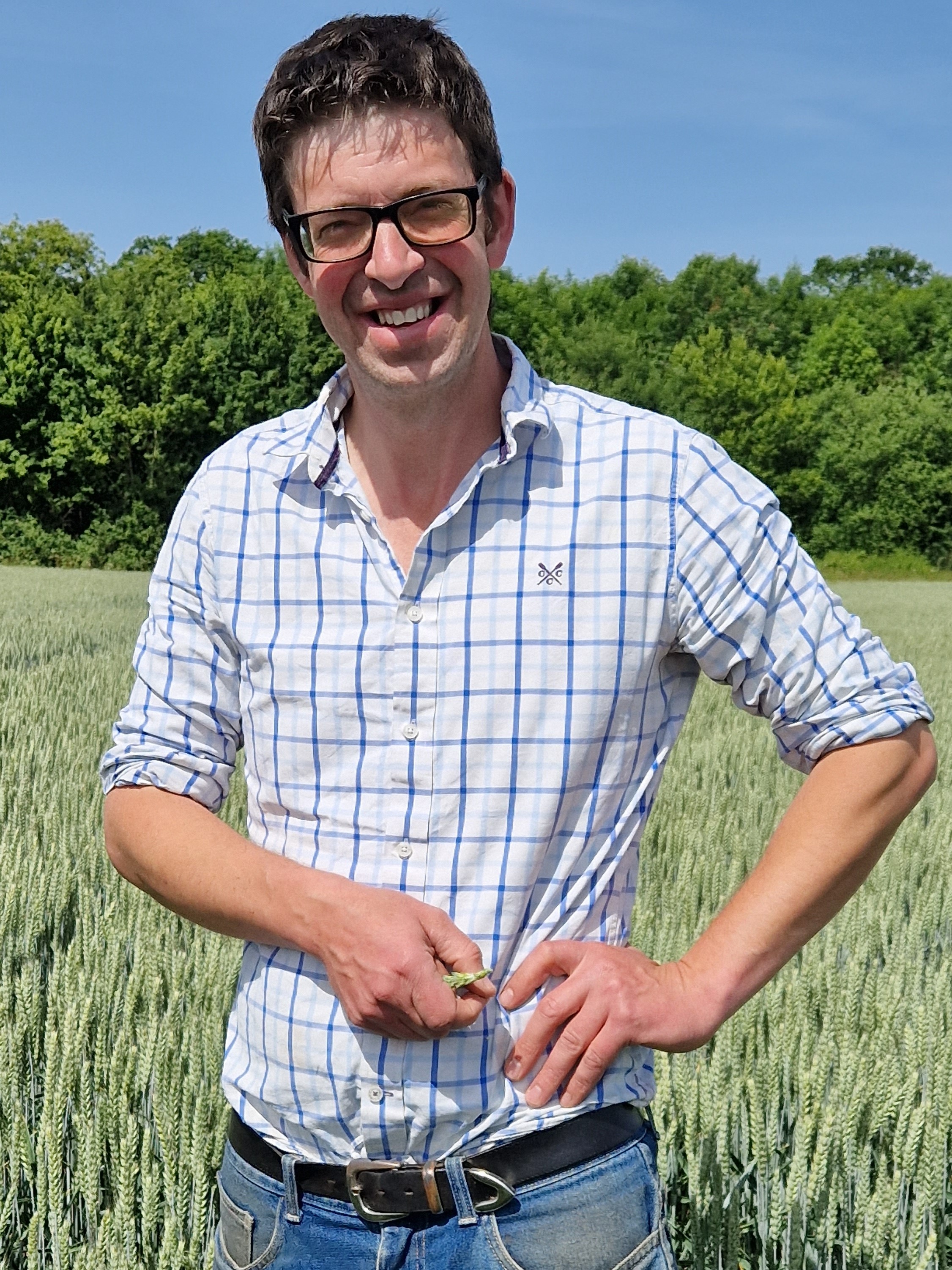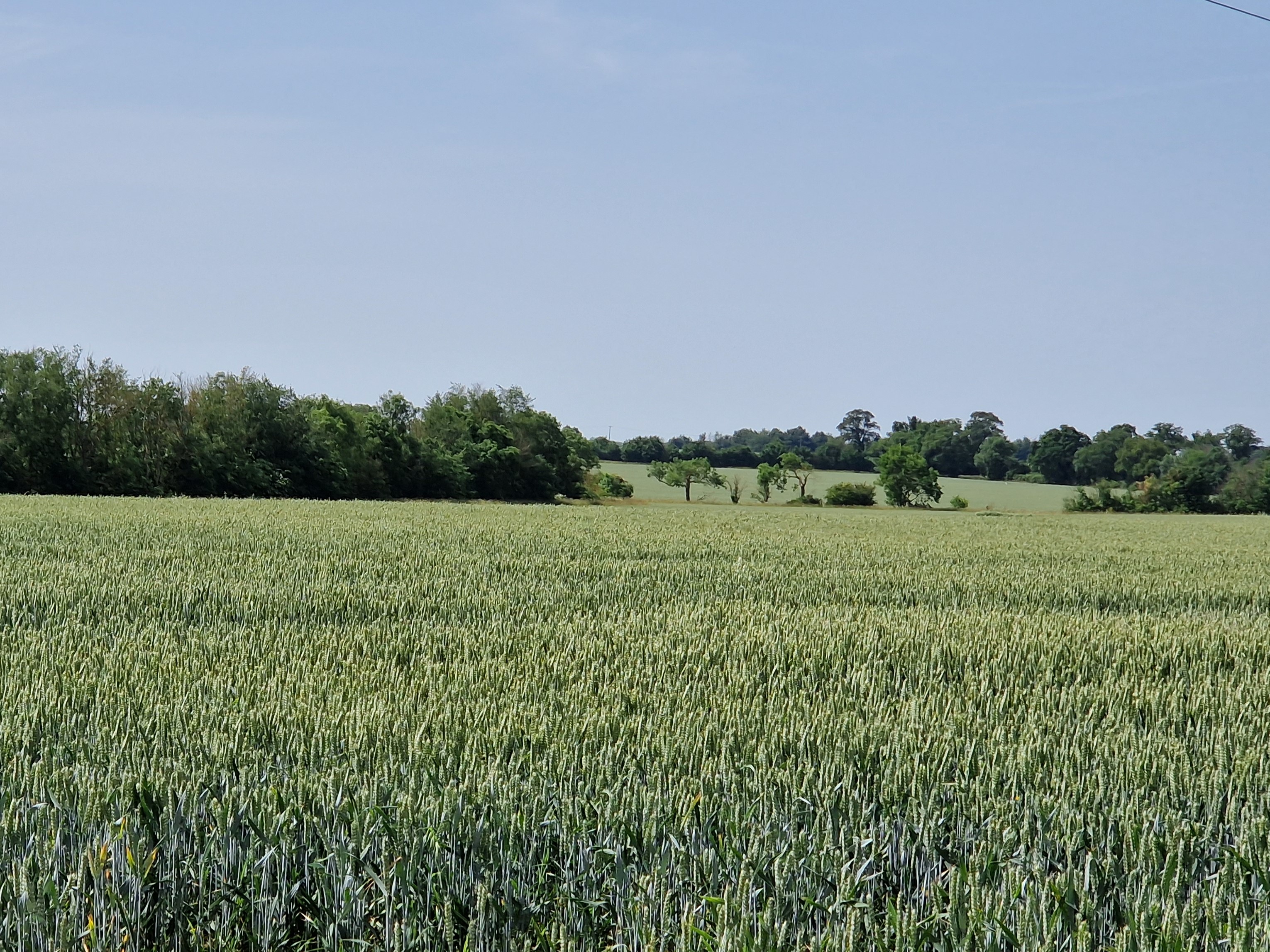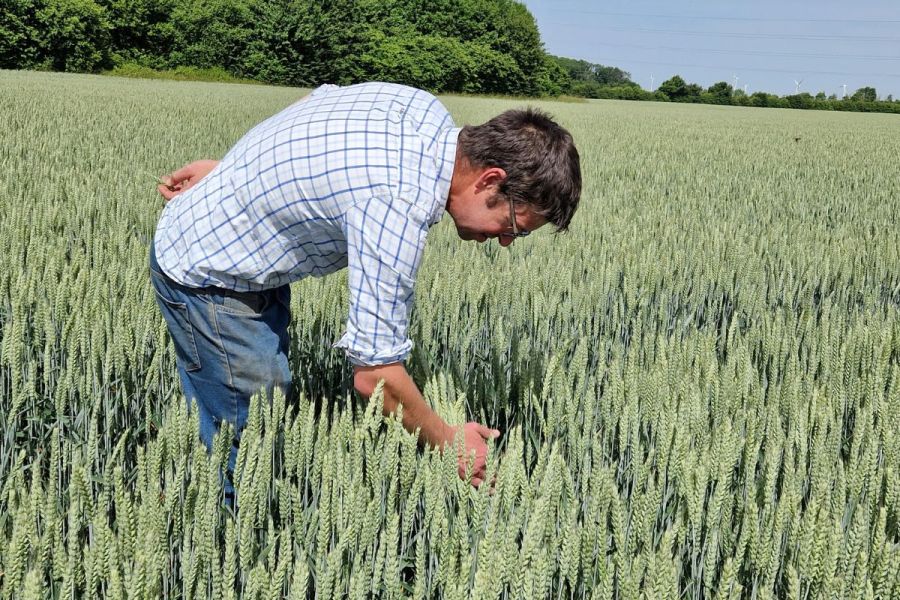Where blackgrass is a problem, delayed drilling is the most effective thing growers can do. CPM visits a Cambridgeshire farm to find out how October drilled crops are being given a helping hand to help make up for any lost growing time.
We’re looking to get the crop off to a flying start to try and regain the days we’ve lost by drilling later.
By Lucy de la Pasture
On the horizon the blades of a cluster of wind turbines are lazily stroking the warm Cambridgeshire air on a very hot day in mid-June – dubbed ‘Fryday’ by mainstream media. Standing surrounded by green wheat ears lapping up the sunshine, Ian Lutey stoops to take a closer look at the crop of SY Insitor.
As he looks across the uniform green in front of him, there’s a gleam in his eye. “If you can’t get excited about harvest at this time of year then you’re in the wrong job,” he smiles.
The crops on the farm have reached the point where as much as could be done has been done. The rest is literally in the lap of the gods. In spite of the predominantly dry spring and early summer, the crop roots still seem to be finding enough water in the Hanslope clay soil surrounding them to look amazingly well. It’s probably no coincidence that Ian gives plant roots a lot of consideration, and that starts before a seed is even before planted.
Ian explains that when he arrived as farm manager for RH Topham and Sons around 14 years ago, blackgrass levels were “horrendous” across the 1435ha farm at St Neots in Cambridgeshire. But even with blackgrass now at manageable levels, it still dictates many of the decisions on the farm.

Ian Lutey says his job is to optimise the farm’s returns while looking after natural capital, which harbours red list bird species skylarks, lapwings and turtle doves.
“We don’t have a fixed rotation, instead it’s kept flexible so that we can do the right thing at the right time to manage the blackgrass population. We do try and block the cropping, but we also have to be able to adapt,” he says.
Winter wheat is the major crop, with around 50% grown as a second wheat. Oilseed rape and winter barley add to the autumn workload, with spring barley and spring oats making up the remainder of the arable cropping.
Unsurprisingly, spring crops play an important role in keeping blackgrass manageable on the farm and Ian gestures to a field the other side of the track which he says was in a spring crop for seven years because the blackgrass population was so high. “It went back into winter wheat last season and we’ve reverted to spring cropping again this year,” he adds.
Heading further out on to the farm, Ian waves a hand towards the wheat to our left. “Wild oats are becoming a bit of a problem on the farm. We spray them out but we’re getting additional flushes later in the spring.”
The label of regenerative farmer doesn’t quite fit the operations at Monks Hardwick but the farm is in the higher tier Countryside Stewardship Scheme and it has a field in the SFI pilot, says Ian. As farm manager his job is to optimise the farm’s returns while looking after natural capital, which harbours red list bird species skylarks, lapwings and turtle doves, he explains.
There’s a keen focus on the soil and Ian says he’s trying to farm in a more carbon-friendly way. “Over the past two years we’ve gone backwards slightly with our blackgrass because of this – we haven’t ploughed as much as we used to.”
Cultivations are predominantly min-till using a Horsch Terrano. Direct drilling his OSR with the 8m Väderstad disc drill in conjunction with a rapid lift low disturbance subsoiler. “Crop establishment is absolutely key, and we want to get roots into moist soil so that the crop gets away as quickly as possible.”
Because blackgrass is the driver on the farm, Ian doesn’t start drilling wheat until 01 October and aims to complete it by 20 October. “Because we’re delaying drilling, we’re looking to get the crop off to a flying start to try and regain the days we’ve lost by drilling later.”

Blackgrass has driven the decision making at Monks Hardwick but is generally well controlled, with late germinating wild oats becoming more problematic across the farm.
And it’s here that Ian believes the odds can be stacked more favourably by using endophyte seed treatment, Tiros. Rather than take any manufacturers’ word for it, he likes to run his own set of trials on the farm for two or three years to get a better idea of what reliably works in his farming system and it’s this approach that has given him confidence in the biological treatment.
“I started off using Take Off (phosphite+ PGA), which showed up significant differences to untreated seed on yield maps and then went on to look at Tiros and Vibrance Duo (fludioxinil+ sedaxane). I’m still trying to decide where the Vibrance fits, but on the basis of my trials, Tiros looks like a step on.”
So what is it about the endophyte seed treatment that has made Ian adopt it as a standard treatment on his wheat seed? “It’s the rooting,” he says without having to think about it. “I’m not sure it emerges any earlier, certainly not against the undressed seed and Vibrance could even be ahead of it, but after a couple of weeks the root mass is impressive. This extra biomass can’t help if the soil runs out of water, but it does buy you extra resilience.”
And as well as improving the plant’s ability to access water, there’s also nutrition to consider and Ian is running split field nitrogen trials this season to help him work out where there may be fertiliser savings to be made.
“The optimum rate of nitrogen has changed this season and we’ve pegged back our applications by about 10%. It wasn’t economics that drove this decision for us as we bought our nitrogen quite well, but more the strong root systems the crops had established. It does mean we can carry some stock over to next year though.”
Ian uses farm-saved seed for 90% of his winter wheat area. “We only buy in seed when we want to try a new variety. We’ve found we get better quality and consistency of seed by growing our own, which we send for testing once harvested. Depending on the results of the testing, we’ll either apply a single purpose dressing plus Tiros or Tiros alone. At around £50/tonne, it’s not a costly treatment.”
The wheat fields give way to spring oats, with panicles shimmering in the slight breeze and fierce sunshine. “We’ve got a trial in this spring looking at Tiros-treated seed oats versus untreated. I’d say that even on a spring crop it’s made a difference, but the combine/weighbridge will be the final judge.”
Moving on, Ian surveys an expanse of OSR which looks particularly uniform and well podded. All the OSR on the farm is hybrid – with Ambassador and Aurelia in the ground for this harvest. “I like the pod shatter resistance you get with hybrids. The Ambassador is up and away early in the autumn and is earlier to harvest, whereas the Aurelia is a bit later to mature. It helps spread the risk.” he says.
Ian isn’t a fan of using a higher seed rate of a conventional as a strategy to ensure enough plants survive flea beetle attack. “You can set yourself up to fail when growing OSR. It’s all about attention to detail and I prefer to approach growing the crop with its success my priority rather than worry about crop failure.
“I’d like to use some Tiros on my OSR but buying it in, you have to go with the options made available to you. I’m hoping this year that it’ll be an option on my OSR seed this autumn.”
Returning towards the yard, he wanders back into a block of wheat. It’s soaking up the sunshine in a peaceful bit of Cambridgeshire countryside while it begins to push nutrients into the grain. Alongside, a bunting flits along the track. Ian looks across the land and says that next year its likely to all look a bit different. “Before long work will begin on a new section of the A428 and it’s going to cut right across here,” he says sadly.
The challenges of farming come in many guises.
One treatment, many benefits
It’s only relatively recently that science has begun to investigate the plant microbiome and start to piece together the relationships between biology and plants.
“There’s a general consensus amongst scientists that microbial communities make a significant contribution to plant health,” says John Haywood, director at Unium Bioscience. “Genomic approaches and classic microbiology are working together to develop the science of plant-microbe interactions and we’re beginning to understand it better.”
The seed treatment Tiros is the outcome of research carried out at University of Washington and subsequently commercialised for use in the field by US firm Intrynsix. It’s a unique consortium of two bacterial endophytes from the University of Washington which colonise and move within the vascular system of the plant, explains John.
Endophytes exist in nature and form relationships with plants, though little is known about how plants actually ‘recruit’ them. They are symbionts which reside in plants for the majority of their life cycle without any detrimental effect on the host plants.
“The particular endophytes in Tiros are bacterial and have been specially selected as they complement each other. They are designed to fix atmospheric nitrogen and to solubilise and sequester phosphorus for a wide range of crops.
“They also increase the uptake of other nutrients to help the plant maintain nutritional balance (stoichiometry), enable the plant to use nutrients more efficiently, and reduce the impacts of abiotic stress and recovery time, especially from drought stress,” explains John.
“Increasing the biomass of roots helps the plant scavenge for nutrients in the soil and improves root exudation, which provides more resources for the biology in the soil to interact with the roots,” says John.
Bacterial endophytes also secrete siderophores and solubilise phosphate in the soil. “Siderophores are secreted by plants and microbes in iron-limited conditions and enable them to chelate iron from the environment. Similarly, phosphorus-solubilising bacteria can make immobile phosphorus in the soil available to plants.”
Perhaps one of the most interesting things about the endophytes in Tiros is their ability to fix atmospheric nitrogen – something that’s normally only associated with the root nodules in pulse crops. “Bacterial endophytes are non-nodulating and because they reside inside plant tissues, this is thought to provide a micro-aerobic environment, favourable to nitrogenase activity (necessary to liberate the N from the nitrogen gas in the air),” says John.
Another seldom realised advantage of Tiros seed treatment is that there is a ‘mother effect’, of particular benefit when using farm-saved seed. “Bacterial endophytes from the maternal community are transferred vertically into the offspring. A recent study has shown that these resume endophytic activity after the seeds are planted.”
A sustainable solution?
The potential of Tiros has also been explored in Syngenta trials, which have looked more closely at its potential to maintain yield while reducing N inputs, explains Andy Cunningham, Syngenta field technical manager.
“It’s clear that developing integrated sustainable growing systems are going to be important into the future to manage inputs while delivering the yields needed to feed the growing population. At Syngenta, we’re very interested in exploring the benefits that endophytes can bring in a wide range of crops to meet these aims by making better use of inputs such as fertilisers and other biostimulant benefits.”
Andy carried out a replicated trial at Syngenta’s Newark Innovation Centre in the 2020-21 season, which was designed to look at Tiros on winter wheat in both a standard and reduced nitrogen regime.
“Throughout the season I saw some very positive benefits, which included a better established and more vigorous crop in the autumn with a bigger root system. This was followed by a healthier crop in the spring, including more chlorophyll in the main yield-creating leaves.
“This all led to the most important aspect – an improvement in yield in both nitrogen regimes. And intriguingly, where Tiros was applied in the reduced nitrogen program, we saw yield was brought back to the level of the untreated standard nitrogen regime.
“This could help create systems for a more sustainable agriculture and we are looking forward to seeing what our trials in 2022 will show.”
Bioscience in practice
As the chemistry toolbox continues to shrink, a mesmerising array of new bio-solutions are coming to market, offering a range of benefits and complementary additions. Evaluating just how effective they are, and where they’re best placed can be tricky.
In 2021, CPM teamed up with Unium BioScience to open the science behind these innovations. In this second series of articles we explore how bioscience can be utilised in the field, building on our understanding of the physiological processes and trials data. Above all, these articles give the grower an inside view on some of the exciting opportunities biosolutions offer in the field.
Groundswell focused the attention on nitrogen and nutrient-use efficiency – this is the arena of Tiros, the leading biological seed treatment from Unium Bioscience. Consistent reports of enhanced yield, improved quality and reduced nitrogen applications are rewarding customers using the endophyte seed treatment. Next year a foliar version, Tarbis, will be availble for those who can’t obtain treated seed.
This article was taken from the latest issue of CPM. For more articles like this, subscribe here.




